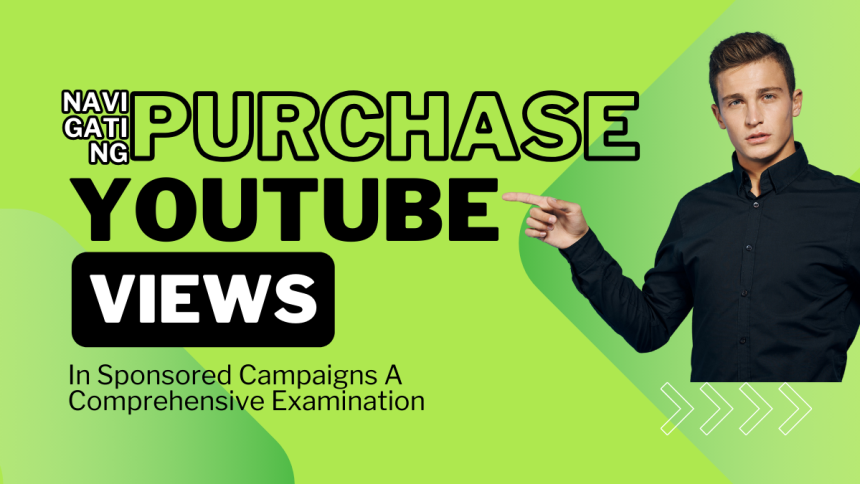YouTube has become a pivotal platform for sponsored content, enabling brands to collaborate with creators to promote products, services, and campaigns to a wide audience. For creators involved in sponsored campaigns, achieving visibility and engagement is crucial to delivering value to their partners. This article delves into the complexities to buy views for YouTube videos in sponsored campaigns, exploring the feasibility, implications, and ethical considerations associated with this practice.
1. Understanding Sponsored Campaigns on YouTube:
Sponsored campaigns on YouTube involve collaborations between creators and brands, where creators feature sponsored content in their videos to promote products or services. These campaigns may include product reviews, brand integrations, sponsored mentions, or dedicated videos tailored to the brand’s objectives and target audience.
2. The Role of Visibility in Sponsored Campaigns:
Visibility plays a pivotal role in the success of sponsored campaigns on YouTube, as higher view counts and engagement metrics can lead to increased brand exposure, audience reach, and campaign effectiveness. Creators strive to maximize the visibility and impact of sponsored content to deliver value to their brand partners and achieve campaign objectives.
3. Considerations for Buying Views in Sponsored Campaigns:
Creators may consider buying views for YouTube videos in sponsored campaigns to enhance visibility, attract a larger audience, and amplify the impact of the sponsored content. However, the feasibility and ethical implications of this practice require careful consideration, as it may impact the authenticity, credibility, and effectiveness of the sponsored campaign.
4. Feasibility and Effectiveness of Purchased Views:
Purchasing views for videos in sponsored campaigns can potentially increase visibility and attract organic traffic to the content. Higher view counts may signal popularity and relevance to viewers, potentially enhancing the campaign’s reach and impact. However, the effectiveness of purchased views in fostering genuine engagement and driving conversions is subject to scrutiny.
5. Transparency and Disclosure:
Transparency is essential when buying views for videos in sponsored campaigns. Creators should disclose any promotional activities or partnerships transparently to their audience, including the use of purchased views. Clear disclosure ensures transparency and fosters trust with the audience, mitigating the risk of perceived deception or unethical behavior.
When it comes to the matter to buy views for YouTube videos in sponsored campaigns raises complex considerations regarding feasibility, ethics, and long-term effectiveness. Creators must carefully weigh the implications of this practice, considering transparency, authenticity, and the integrity of their brand partnerships. By prioritizing organic growth strategies, delivering valuable, engaging content, and fostering genuine connections with viewers, creators can maximize the visibility and impact of sponsored content on YouTube without resorting to deceptive practices such as buying views.
A Comprehensive Guide to Buying Views for Videos in Various Formats: Exploring 360-Degree and VR Content
With the advent of immersive technologies like 360-degree and virtual reality (VR), creators have expanded their horizons, offering viewers unique and engaging experiences. However, gaining visibility for such content can be challenging due to its specialized nature. In this article, we delve into the strategies and considerations for buying views for videos in different formats, specifically focusing on 360-degree and VR content.
1. Understanding 360-Degree and VR Content:
360-degree videos allow viewers to explore scenes from all angles, offering an interactive and immersive viewing experience. VR content goes a step further by enabling viewers to experience virtual environments in a three-dimensional space, often using VR headsets for enhanced immersion. Both formats offer new avenues for storytelling and engagement.
2. Challenges in Gaining Visibility:
Despite their potential for immersive storytelling, 360-degree and VR content faces challenges in gaining visibility on traditional platforms like YouTube. The specialized nature of this content may limit its exposure to a broader audience, requiring creators to explore alternative strategies for increasing visibility and engagement.
3. Identifying Target Audience and Objectives:
Before buying views for 360-degree and VR content, creators should identify their target audience and define their objectives. Determine the demographics, interests, and preferences of your target audience to tailor your promotional efforts effectively. Clarify your objectives, whether it’s increasing brand awareness, driving engagement, or generating leads.
4. Optimizing Metadata and Keywords:
Optimize the metadata and keywords of your 360-degree and VR videos to improve their discoverability on platforms like YouTube. Use descriptive titles, tags, and descriptions that accurately reflect the content and appeal to your target audience. Leverage relevant keywords related to the subject matter, format, and immersive experience.
5. Leveraging Targeted Promotion:
Consider targeted promotion options to reach audiences interested in immersive content. Leverage social media advertising, email marketing, and influencer partnerships to promote your 360-degree and VR videos to relevant communities and enthusiasts. Target specific demographics, interests, and geographic locations to maximize relevance and engagement.
6. Creating Compelling Thumbnails and Previews:
Thumbnails and previews play a crucial role in attracting viewers to your 360-degree and VR content. Create visually compelling thumbnails that showcase the immersive experience and intrigue viewers to click and explore further. Use captivating imagery and descriptive text to entice viewers and convey the unique nature of the content.
7. Monitoring Performance and Adjusting Strategies:
Monitor the performance of your 360-degree and VR videos regularly and adjust your promotion strategies accordingly. Track metrics such as view count, watch time, audience retention, likes, comments, and shares to gauge the effectiveness of your promotional efforts. Analyze audience feedback and engagement patterns to refine your content and promotion strategies over time.
8. Ethical Considerations and Transparency:
Maintain transparency and ethical integrity when buying views for 360-degree and VR content. Disclose any promotional activities or partnerships transparently to your audience, including the use of purchased views. Prioritize authenticity, accuracy, and credibility in your content creation efforts to build trust with your viewers and uphold the integrity of the immersive experience.
Final Verdict:
While the pont to buy views for 360-degree and VR content requires a strategic approach tailored to the unique challenges and opportunities of immersive storytelling. By identifying target audiences, choosing reputable service providers, optimizing metadata, leveraging targeted promotion, and maintaining transparency, creators can effectively increase the visibility and engagement of their immersive content. With careful planning and execution, 360-degree and VR videos can reach a broader audience, captivate viewers, and offer unforgettable immersive experiences.
More Details: https://buyyoutubviews.com/
Lynn Martelli is an editor at Readability. She received her MFA in Creative Writing from Antioch University and has worked as an editor for over 10 years. Lynn has edited a wide variety of books, including fiction, non-fiction, memoirs, and more. In her free time, Lynn enjoys reading, writing, and spending time with her family and friends.















